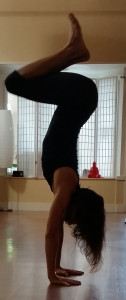Turn your life upside down with handstand
by Nancy B. Loughlin
Published in News Press on February 21, 2015
Turn your life upside down, both literally and figuratively.
We upend ourselves when we enter or exit a romantic partnership, quit a job or move and start over. We let go of stubborn ideologies that no longer serve us, and we wander open-eyed into the intellectual wilderness. We abandon fantasy and/or denial and, untethered, embrace reality.
Invite and practice a little bottoms-up mayhem with handstand. Although it can be scary, a handstand is good for the body because it reverses blood flow, granting relief to the legs and feet; increases balance; strengthens your bones and builds upper-body strength.
Fresh perspectives are the fountain of youth.
Build strength with plank. Before attempting handstand, hold the top of a push-up position. Push the floor away from you with your palms, fingers spread wide, and press down your toes. As if you were in Mountain Pose, activate your front body, your core, your quads and kneecaps, and lift. Feel the space between your shoulder blades widen and your arms elongate as if you are giving someone a hug. Hold for a minute and build to three. When you are strong enough, lower to Chaturanga, half a push-up, and hold.
Begin to invert. Hold Downward-Facing Dog with the backs of your heels against the wall. Activate your shoulder girdle, and push the floor away from you with your hands. Now walk your feet up the wall until you are an inverted capital L, your feet parallel with your hips. Hold for ten breaths or longer.
Supported handstand. Face the wall. Take a deep breath, and, on the exhale, lower your palms to the floor. On an inhalation, kick one leg toward the ceiling. With enough momentum, your second leg will follow. Eventually.
Don’t be surprised if you hesitate to make your move. Instead of “just do it,” try “wait for your moment.” Kick up only when you’re ready, in handstand and in life.
You’ll notice that in order to maintain your balance, you need to activate far more than your arms and hands. A handstand involves the shoulders, the large muscles in the back, the obliques and the rectus abdominis, the psoas and the glutes.
Once you’re in handstand, flex your feet with your toes touching the wall. Ignite the shoulder girdle by pushing the floor away from you. In sync with the breath, pull one foot away from the wall then the other.
Enjoy your new view.

